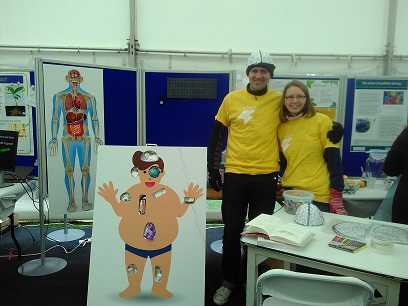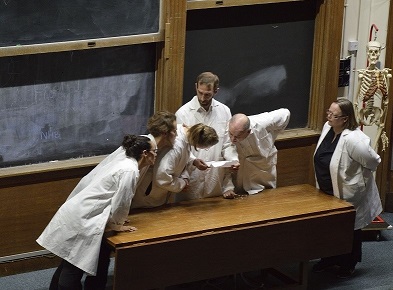An overview of the HATG's activities sharing educational approaches and research activities with the public. We see this as a two-way process, and welcome opportunities to interact and listen. Our goals are to generate a better understanding of anatomy and maintain a reflective, respectful educational programme.

Public engagement
Exhibition of Anatomical Models
16-18 September 2019
Our Department hosted an exhibition of Anatomical Models with three talks on: From wax to virtual: a brief history of anatomical models, Teaching veterinary anatomy with models and How to model our supercomputer: the human brain. Different types of anatomical models were presented in the Anatomy Seminar Room. The exhibition was developed by Sue Jones, Dr Roberto Inchingolo, David Bainbridge and Cecilia Brassett. Groups of secondary school students enjoyed learning about the different ways in which anatomical models could be made, and were able to handle some of the plastic models used for teaching.
Dying for life: information, ideas and conversation
Saturday 12th May 2018, Arthur Rank Hospice, Cambridge
Dr Cecilia Brassett, University Clinical Anatomist, and Mrs Maria Wright, Chief Teaching Technician, represented the The Human Anatomy Teaching Group at an information stand at this free event organised by Dying for Life and the Arthur Rank Hospice Charity. The day included a mixture of short talks, longer talks, information and informal conversations. Cecilia and Maria shared their experiences and the benefits of whole body dissection for teaching our future doctors.
The truth behind donating your body to a medical school
An interview with Dr. Cecilia Brassett, MB BChir MChir FRCS (click here to read the interview and watch a video about anatomical teaching at the University of Cambridge). Cecilia Brassett is the current University Clinical Anatomist at Cambridge University, where she is responsible for organizing the anatomy teaching programme. She also collaborates with a number of clinicians on research projects on clinically relevant aspects of topographical anatomy.
The interview covered questions including:
How are donated bodies used to train medical students? What happens to bodies that are donated to medical schools? Why is dissection still an important part of training? What are the acceptance criteria for donating your body to anatomical examination? And why is it important to specify anatomical examination and not “science” in your will, if you would like to donate your body to a medical school?
The Cambridge Science Festival 2018
The HATG Junior Anatomy Demonstrators devised further anatomical delights for the public at this year’s Cambridge Science Festival. Our stand included a mega-sized version of the popular children’s game, Operation, but with a twist: the objects removed from the body cavities related to the etymology of anatomical words. For older children and adults, organs were attached to a more realistic model showing the location of anatomical structures. Visitors were also entertained manufacturing paper ‘brain hats’ showing the lobes of the brain and the types of behaviour and activity they are each responsible for. This year's program was devised by Junior Anatomy Demonstrator, Miss Ruth Townend (Clinical Fellow, General Surgery, Addenbrooke's Hospital) with Mr Rory Thompson (Clinical Fellow, Urology) and Dr James Thompson (Clinical Fellow, ENT).
Festival of Ideas: The Secret Language of Anatomy
Cecilia Brassett and Isla Fay presented a public lecture on the etymology of anatomical terms on 18 October 2018.
Why are parts of the human body named in a certain way? What similarities do diverse everyday objects such as ornaments and utensils have with anatomical structures? The plethora of unfamiliar terms used to describe organs and tissues may well appear bewildering to the uninitiated. In this talk, we brought to life the rich imagery that was adopted by the anatomists of the past, and decoded patterns in the naming of diverse structures in different regions of the body.
Taking inspiration from agricultural tools to instruments of war, from the rooms of a Roman villa to features of the surrounding landscape, the ancient anatomists gave vivid, evocative descriptors to the structures they observed, thus creating a rich and colourful vocabulary which continues to delight and fascinate us today.
BBC Cambridgeshire Drivetime with Thordis Fridriksson: The Ignorance Amnesty
Cecilia Brassett, University Clinical Anatomist, and Isla Fay, Human Anatomy Technical Coordinator, talked to Thordis about body donation, surgical training and the mysterious etymology of anatomical terms.
Celebrating 600 years of the Cambridge University Library: Lines of Thought Exhibition
The Lines of Thought exhibition celebrates 600 years of the University Library by tracing six key concepts that have shaped the world, including “Illustrating Anatomy: Understanding the Human Body”. Maria Wright, our Senior Teaching Technician, contributed a painstakingly prepared, prize-winning anatomical prosection of the hand for the exhibition. First-year students medical students learn anatomy first-hand by performing whole-body dissection for themselves, as well as seeing structures displayed in anatomical prosections such as this one. This photograph will be on display at the Milstein Exhibition Centre in the University Library until 30 September 2016.
Festival of Ideas: Theatre Production of Professor Bernhardi in the Anatomy Lecture Theatre
In collaboration with Dr Annja Neumann, Research Associate of the Schnitzler Digital Edition Project and affiliated lecturer at the Department of German and Dutch, a production of Arthur Schnitzler’s hard-edged comedy Professor Bernhardi (1912) will be staged in the Anatomy Lecture Theatre on 29 October 2016.
In the play, a Jewish doctor who prevents a Catholic priest from administering the last rites to a patient who is unaware that she is dying. This new adaptation by Judith Beniston and Nicole Robertson, performed by London-based theatre company [Foreign Affairs], takes a wry look at the ethical choices made in hospitals that are as relevant now as they were in Schnitzler’s time. The play will explore anatomical teaching spaces through a choreography focusing on the movement of doctors. A pre-show talk by Annja Neumann and Cecilia Brassett will introduce the venue and the play.
Further details and how to book tickets will be announced on the Festival of Ideas website.

Virtual Museum
Our Virtual Museum aims to make a collection of historically important and valuable anatomical specimens accessible as “3D” rotatable images. As these rare specimens are vulnerable to handing, they are not used in routine teaching sessions. We hope a digital collection will enhance student learning and public appreciation of these artefacts. In addition, collections of osteological specimens showing normal features and pathological conditions will be photographed and displayed to supplement our anatomy teaching programme.
Cambridge Science Festival 2017
The Human Anatomy Teaching Group and Junior Anatomy Demonstrators contributed three events to the 2017 Science Festival:
- 'Anatomy at the "cutting edge": dissection-based teaching at Cambridge through the years' (lecture by Dr Cecilia Brassett, Prof. David Riches, and Dr Sue Jones)
- 'The re-birth of anatomical art' (lecture by Ms Emily Evans, Anatomy Boutique)
- Public anatomy education day (marquee event, including anatomical face painting, 'build-a-body', bone demonstration and limb-building exercises, historical perspectives through the work of da Vinci and Vesalius, examples of interactive techniques used within the Functional Architecture of the Body course).
Our contribution to the festival was organised by Thomas Lloyd, Emily Ross, Dimitris Challoumas, Adam Pilarski, and Lucy Grant.
A poster on science engagement based on the event received the poster prize at the 2017 meeting of the Alcock Society's 7th Annual Meeting, Gordon Museum, Guy’s Hospital, London.



